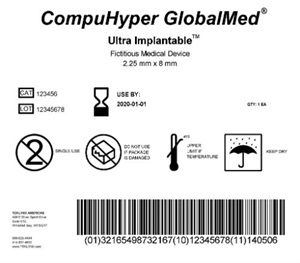Please select your location & language for the best website experience
In the medical device industry, accurate identification has never been more important. Failure to adhere to rules and regulations can be the difference between life and death for patients. Growing concerns about product recalls, counterfeit devices and patient safety are leading to changing trends and increased regulations.
Differing descriptions of medical/surgical products and conflicting data has created problems within the U.S. healthcare industry supply chain. Unverifiable product data is being spread from organization to organization, which has led to challenges around product recalls, storing expired inventory, shipping incorrect products and more serious problems – all of which are preventable.
In effort to increase patient safety, reduce costs and improve efficiencies, the Food and Drug Administration (FDA) released a final rule on September 24, 2013, requiring that medical devices distributed in the United States be documented and tracked by a Unique Device Identifier, or UDI.
With the first compliance date rapidly approaching, now is the time to move from learning about the regulation to taking action and implementing key components to meet the requirements.
In order to comply with the UDI legislation, manufacturers must assign a UDI-compliant code to their product, use labeling software to label the products with the UDI and publish the data to the Global Unique Device Identification Database (GUDID), which will include a standard set of basic identifying elements for each device with a UDI.
Here are three steps to take to ensure compliance:
What, exactly, is a UDI? A Unique Device Identifier (UDI) is a system used to mark and identify medical devices within the healthcare supply chain, comprising a unique numeric or alphanumeric code with two parts:
 It is also important to choose a label design software that is capable of printing the GS1 and Health Industry Bar Code (HIBC) and generate the AIDC technology for placing a UDI on labels for medical devices. “Ease of use and efficiency in generating labels that can meet GS1 barcode standards – like the requirements of UDI – are a vital consideration when choosing a label design software,” said David Kane, Label Design Product Manager of TEKLYNX Americas. “When choosing a labeling software, closely review the features to ensure that you can easily and efficiently meet UDI requirements.”
It is also important to choose a label design software that is capable of printing the GS1 and Health Industry Bar Code (HIBC) and generate the AIDC technology for placing a UDI on labels for medical devices. “Ease of use and efficiency in generating labels that can meet GS1 barcode standards – like the requirements of UDI – are a vital consideration when choosing a label design software,” said David Kane, Label Design Product Manager of TEKLYNX Americas. “When choosing a labeling software, closely review the features to ensure that you can easily and efficiently meet UDI requirements.”
The first compliance date is effective on September 24, 2014, one year after publication of the final rule, when all labels and packages of Class III medical devices, which usually sustain or support life and/or are implanted, such as a pacemaker, and devices licensed under the Public Health Service Act (PHS) Act (for example, donor screening assays) must bear a UDI. Noncompliant companies can be banned from cross-state selling. By September of 2020, Class I devices, such as elastic bandages, must bear UDI on the device itself if it is intended to be used more than once and reprocessed before each use.
Implementing this legislation will increase patient safety by:
As rules and regulations are finalized and compliance dates approach, it is important to become familiar with the details of the UDI legislation and how to achieve compliance. "Medical device labeling will be vital for success of the legislation, and in improving patient safety," said Kane. "By changing the way you label products, you can minimize costs and increase efficiencies throughout your organization and the industry supply chain." It is best to get started now to implement a plan to reach UDI compliance by the mandated deadline, and realize long-term benefits from being able to do business with your customers in a different, better way.
About the Author
Nick Recht is the Enterprise Product Manager at TEKLYNX Americas, where he strives to use technology to add value and create efficiencies in manufacturing and business environments. Nick holds a Bachelor’s degree in Business Administration with a focus in Managing Information Systems (MIS) from the University of Wisconsin-Milwaukee. Nick can be reached at 414-837-4765 or via email at [email protected].
About TEKLYNX
TEKLYNX International is the world’s leading developer of barcode labeling software solutions. More than 600,000 companies in 120 countries rely on TEKLYNX integrated software solutions for supply chain automation, regulation compliance, warehouse management, shipping and receiving, inventory control, and asset management. TEKLYNX is a Microsoft Gold Certified Partner, Oracle Gold Partner, has internal GS1 Certified Barcode Professionals and invests to develop SAP Certified solutions. TEKLYNX barcode labeling software is CFR Part 11 compliant, and is capable of printing GS1 and HIBC required to generate the AIDC technology labels for UDI compliance, with support for thermal and thermal transfer printers.
© Copyright 2025 TEKLYNX CORPORATION SAS. All Rights Reserved.